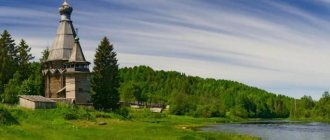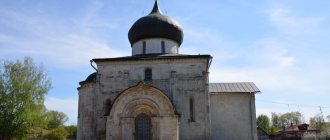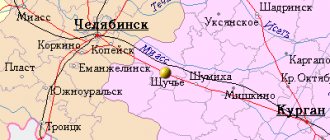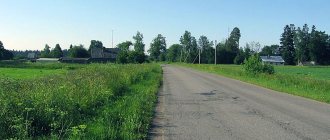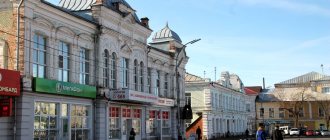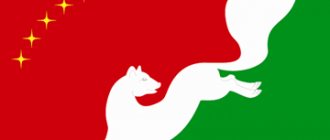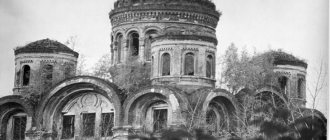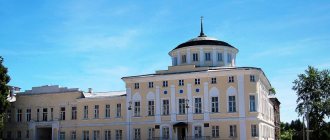The city of Nerekhta, located 46 km from Kostroma, has an ancient history. “Nerekhta” in the language of the Meryans, who once inhabited the environs of the modern city, meant “a river in a lowland, a swamp.” According to another version, the name of the city means “fish spawning place.”
The first mention of Nerekhta dates back to 1214 in connection with the fight for it by the children of Prince Vsevolod the Big Nest. It is likely that a settlement was founded here long before this. The floodplain of the Solonitsa River has been famous for its salt springs since ancient times. Salt was highly valued and was one of the items of princely income, so these places were especially attractive for ownership.
Coat of arms of Nerekhta
In 1362, the ancient city of Nerekhta was mentioned in the handwritten Life of St. Pachomius of Nerekhta, who founded the Trinity Monastery near the city. In 1406, Grand Duke Vasily Dmitrievich gave Nerekhta to his wife Sofya Vitovtovna. At this time, they were already actively engaged in salt production. In 1462, Grand Duke Vasily the Dark gave Nerekhta with the varnitsa to his wife Maria Yaroslavna. With the introduction of the oprichnina, many Kostroma and Galich cities were “taken over by the sovereign.” In 1609 Nerekhta was burned and devastated by the Poles; its restoration took many years. However, already in the 18th century, salt production here finally ceased due to the appearance in Russia of salt that was cheaper to produce. If it weren’t for the city’s favorable location on trade routes to Yaroslavl, Kostroma, Nizhny Novgorod and Suzdal, it is quite possible that Nerekhta, deprived of its main industry, would have completely deteriorated.
In 1678, on the way to the Florishcheva hermitage, Tsar Fyodor Alekseevich stopped for several days in Nerekhta with his wife and younger brothers John and Peter. Six-year-old Peter donated the altar gospel to the Vladimir Church. Fyodor himself gave money for the construction of the Vladimir Church in stone - the first monumental building in the city.
Wooden houses with openwork platbands
At the beginning of the 18th century, Nerekhta, with the status of a suburb, became part of the Kostroma province of the Moscow province. During this period, the first industrial enterprises were created and flax began to be grown in the area. At first, weaving was done by peasants, but gradually it reached the industrial level. In 1761, local merchants Lapshin-Gryaznovsky and Pastukhov built a weaving factory in the city, which has survived to this day. And by the beginning of the 19th century, several manufactories were already functioning in the city. The fabrics produced here were famous for their quality not only in Russia, but also abroad. Nerekhta is gradually turning into one of the major centers of manufacturing production.
In 1778, by decree of Catherine II, Nerekhta received the status of a district town of the Kostroma province and was assigned a coat of arms. Two severe fires - in 1785 and 1838 - destroyed most of the city's buildings. As a result, a new general plan for the city was drawn up, which established a radial-circular street pattern. This layout has survived to this day.
Church of the Annunciation in an old photograph
Among the townspeople there were many wealthy artisans; residents were successfully engaged in gardening; 3 fairs and weekly markets were held in the city annually.
During Soviet times, Nerekhta continued to develop as one of the industrial centers of the Kostroma region. In 1970, the city was included in the list of cities of the Small Golden Ring of Russia. In 2014, Nerekhta turned 800 years old.
We will start our walk around Nerekhta on Rosa Luxemburg Street, where the Church of the Annunciation (21 Rosa Luxemburg Street). It was built at the beginning of the 18th century on the site of a dilapidated wooden church. The church was an octagon on a quadrangle, ending with a five-domed structure with the northern Athanasius-Kirillovsky chapel, also completed with an octagon. The refectory with St. George's chapel and the three-tier bell tower in the Baroque tradition were built in 1772 according to the design of local architect Stepan Vorotilov. The church was closed in 1931, its wedding ceremony was broken. So far the temple remains unrestored.
Bell tower of St. Nicholas Church
Let's follow the street until it intersects with Lenin Street. Turning left, you will soon come to the Vladimir Church (Lenin St., 28b), which was built in 1678-1688 and became the first stone church in Nerekhta. Tsar Fyodor Alekseevich made a contribution to the construction of the church of the Mother of God Sretensky Monastery in 1678, and Peter I gave 250 rubles for its completion in 1685. In 1700, a hipped bell tower was added, in 1718 - abbot's cells and a fence. Externally, the church is close to the Yaroslavl churches of the 17th century: a huge quadrangle with a powerful five-domed dome, an elegant porch, tiles, paintings on it and in the corners. In 1764, the Sretensky Monastery was liquidated, the church was transferred to the category of parish.
Researchers attribute the painting of the temple, made in 1775, to the brushes of Yaroslavl resident Mikhail Alekseevich Soplyakov.
In the 30s of the 20th century, the temple was badly damaged; its restoration began in 1995. Since 2004, Vladimir Cathedral has been transferred to the church.
Vladimir Church
Returning back, we will examine the Cathedral of the Kazan Icon of the Mother of God (Lenin St., 2).
The initiator of its construction was Peter I, 2 weeks before the decisive battle with the Swedes near Poltava, he wished to dedicate the temple to the Kazan Icon, to which he turned for help for victory. Construction was completed in 1713, and the cathedral was painted in 1780.
The cathedral has survived to this day in a greatly changed form: deprived of the five-domed structure, apse, fence and equipped with later extensions, it was used for a long time as a bakery building. What sets it apart from the total mass of buildings is only the upper part of the quadrangle with zakomars. The Kazan Cathedral is the architectural dominant of the central square of Nerekhta; its soaring bell tower seems to crown the surrounding space.
Here on the square there are Trading Rows (30th Anniversary of Freedom Square), built according to the design of the architect Pyotr Fursov, the author of the fire tower and guardhouse in Kostroma. In 2014, for the 800th anniversary of the city, a large-scale reconstruction was carried out.
At the intersection with Volodarskogo Street there is the Church of the Epiphany (Volodarskogo Street, 1a), better known as Nikolskaya after the chapel of the same name. Its construction to replace the burnt wooden church began in 1710 and lasted 15 years, until 1725.
Shopping arcades
The church plays an extremely important role in shaping the architectural appearance of the left bank part of the city. The quadrangle ending in five domes is adjoined from the east by a three-part apse, and from the west by a rectangular refectory and a slender hipped bell tower with a six-column portico. The bulbous scaly heads rest on blank smooth drums, the only decoration of which is the cornice. Along the perimeter of the roof of the quadrangle there is an openwork valance, an example of decorative and applied art.
In the 30s, the temple was beheaded, the apses, bell tower and fence were broken, and in the 80s of the 20th century, the bell tower was restored according to the design of the architect A.P. Chernova.
Domes of the Cathedral of the Epiphany
The interior decoration has preserved paintings that are distinguished by their realism and great picturesqueness. In 1987, 3 iconostases from 1776 were installed in the church, transported here for preservation purposes from the village of Verkhovye, Soligalichsky district.
A little further down the street. Volodarsky there is the Church of the Resurrection (Varvarinskaya). The church was built in 1770-1787 by Kostroma architect Stepan Andreevich Vorotilov. It is a two-story building in the Baroque style. The main volume, like an octagon on a quadrangle, is covered with a dome with lucarnes and a small refectory, connected to a three-tier bell tower. Below is the warm Varvara Church. The church was closed in the 1930s and was used for housing and an incubator. After restoration in 1983-1995, one of the exhibitions of the local history museum was located here. Relatively recently, the temple was transferred to the Russian Orthodox Church.
Church of the Resurrection (Varvarinskaya)
Today it is one of the brightest and most harmonious baroque churches in the Kostroma region.
Returning back, we will walk along the street. Ordzhonikidze and further along Gagarin Street to the Holy Cross Church (Gagarin Street, 22). This is a cemetery temple complex typical of the former district town, located on the northern outskirts of the city near the road to Kostroma. The construction of the Church of the Exaltation of the Cross with the chapel of Dmitry Thessalonica was carried out at the expense of the Nerekhta merchant and mayor Dmitry Prokofievich Simonov, and was completed in 1788 (consecrated in 1793). The architect was probably S.A. Vorotilov, as evidenced by some features of the church and bell tower.
In the temple, under later records, wall paintings, originally executed in oil in 1810 by the artist Alexei Timofeevich Demidov, were partially preserved. During Soviet times, the church did not close.
Entrance to the territory of the Church of the Exaltation of the Cross
Having completed your tour of the main temples of the city, you can go to the Nerekhta River, narrow, like a ribbon, but incredibly picturesque. From here you can enjoy unforgettable views of the city, crowned with the domes of churches.
There are also a lot of interesting things in the vicinity of Nerekhta. If you have time, go to the Trinity-Sypanov Pakhomiyevo-Nerekhta Convent (Nerekhta district, Trinity village).
The founder of the monastery was the Monk Pachomius of Nerekhta, the son of a priest from Vladimir, a student of Sergius of Radonezh. Seeking solitude and seclusion, he settles on the banks of the Solonitsa River not far from Nerekhta in a place that since ancient times was called Sypanovo. With the help of the residents of Nerekhta, the monk built a wooden church here in the name of the Life-Giving Trinity (about 1365-1378); Gradually, other buildings appeared around the temple; under the hill on which the church was located, a holy spring appeared through the prayers of the elder. In 1384, the Monk Pachomius died and was buried in the Trinity Church he had erected.
Nerekhta River
In 1675-1676, on the site of a wooden church, a stone one, also Trinity, was erected; the relics of St. Pachomius remained at the new church. In 1679-1686, the “warm” (winter) Church of the Intercession was erected, in 1683-1684 - a tented bell tower, a little later - abbot and fraternal cells, a stone fence with the Holy Gate.
In 1764, during the monastic reform, the monastery was abolished, and the temple was turned into a parish. However, numerous pilgrims kept the ancient monastic traditions; the custom of descending and ascending the monastery mountain three times from the monastery to the holy spring with prayer to St. Pachomius has still been preserved.
Traditional doll
During Soviet times, the temple was closed, and attempts were made repeatedly to destroy the source at the ancient monastery. And in 1992 the monastery was revived (as a convent). The Trinity Church was restored, a new sister's building and an almshouse were built in the monastery.
Shrines of the monastery:
- holy relics of St. Pachomius of Nerekhta;
- the miraculous Vladimir Nerekhta Icon of the Blessed Virgin Mary;
- holy spring of St. Pachomius.
Well in the monastery
Pachomiev-Nerekhta Convent
Image of the Nerekhta Icon of the Mother of God
The copy of the Vladimir Icon is one of the most famous shrines of ancient Nerekhta. According to legend, in 1634. The Mother of God appeared in a dream to a resident of the city of Yaroslavl, John Averkiev, and ordered him to go to the icon painter, take the icon of the Most Holy Theotokos of Vladimir and take it to Nerekhta. John, having doubts, disobeyed and became seriously ill. And only after delivering the icon to Nerekhta, where it was solemnly greeted by the clergy and residents of the city, was he immediately healed. The icon was placed in a wooden chapel, and later the Sretensky Monastery was built nearby. Tsar Fyodor Ioannovich, who visited Nerekhta in 1678, ordered the construction of a stone temple in the monastery. The Vladimir Cathedral was consecrated in 1686; after the abolition of the monastery, the icon continued to be kept within its walls. And only after the closure of the temple in the 30s of the 20th century, the miraculous icon, like all the decoration of the temple, disappeared without a trace. The shrine was discovered in 1983. After restoration, it was in the museum, then in the Holy Cross and Transfiguration churches in the city of Nerekhta. In May 2004. The Vladimir Cathedral of the city of Nerekhta was transferred to the church; from the same time, the revered image of the Queen of Heaven resides in the Trinity-Sypanov Pachomiev-Nerekhta convent and is brought to services held on special holidays in the Vladimir Cathedral.
Links[edit]
Notes[edit]
- ^ abcdefg Law No. 112-4-ZKO
- ^ B "General information" (in Russian). Retrieved February 24, 2022.
- ^ a b Federal State Statistics Service (2011). “All-Russian Population Census 2010. Volume 1" [All-Russian Population Census 2010, vol. 1]. All-Russian Population Census 2010 [All-Russian Population Census 2010]
. Federal State Statistics Service. - "26. The size of the permanent population of the Russian Federation by municipalities as of January 1, 2022". Federal State Statistics Service. Retrieved January 23, 2022.
- ^ abcde Law No. 237-ZKO
- "On the Calculation of Time". Official Internet portal of legal information
. June 3, 2011. Retrieved January 19, 2022. - Post office. Information and computing center of OASU RPO. ( Post office
).
Search for postal service objects ( postal Search for objects
) (in Russian) - ↑
Federal State Statistics Service of Russia (May 21, 2004).
“The population of Russia, the constituent entities of the Russian Federation as part of federal districts, urban settlements, settlements, settlements of 3 thousand or more people” [Population of Russia, its federal districts, federal districts, districts, urban settlements, rural settlements - administrative centers and rural settlements with a population of more than 3,000 people] (XLS). All-Russian Population Census 2002
. - “All-Union Population Census of 1989. The current population of union and autonomous republics, autonomous regions and districts, territories, negative phenomena, urban settlements and rural district centers” [All-Union Population Census of 1989: current population of union and autonomous republics, Autonomous regions and districts , territories, regions, districts, towns and villages performing the functions of district administrative centers. All-Union Population Census of 1989 [All-Union Population Census of 1989]
.
Institute of Demography of the National Research University: Higher School of Economics [Institute of Demography of the National Research University: Higher School of Economics]. 1989 - via Demoscope Weekly
. - Resolution No. 133-a
- Team image
- ↑
Poster of the match in Borovichi with the participation of the Start team - https://www.rusbandy.ru/season/322/
Sources [edit]
- Kostroma Regional Duma. Law No. 112-4-ZKO of February 9, 2007 “On the administrative-territorial structure of the Kostroma region,” as amended. Law No. 567-5-ZKO of September 24, 2014 “On amendments to the Law of the Kostroma Region” On the administrative-territorial structure of the Kostroma Region “”. Came into force on the date of official publication. Published: “SP - normative documents”, No. 10 (70), February 28, 2007 (Kostroma Regional Duma. Law No. 112-4-ZKO of February 9, 2007 “ On the administrative-territorial structure of the Kostroma Region”,
as amended, introduced by Law No. 567-5-ZKO dated September 24, 2014 “
On Amendments to the Law of the Kostroma Region”).
"On the administrative-territorial structure of the Kostroma region" . Valid from the date of official publication.). - Administration of the Kostroma region. Resolution No. 133-a of April 8, 2014 “On approval of settlements in the Kostroma region.” Entered into force on April 11, 2014. Published: “SP - regulatory documents”, No. 15, April 11, 2014 (Administration of the Kostroma Region. Resolution No. 133-a of April 8, 2014 “ On approval of the register of settlements in the Kostroma Region
.” Valid from April 11, 2014"). - Kostroma Regional Duma. Law No. 237-ZKO of December 30, 2004 “On establishing the boundaries of municipalities in the Kostroma region and granting them status,” as amended. Law No. 496-5-ZKO of February 28, 2014 “On Amendments to the Law of the Kostroma Region” On establishing the boundaries of municipalities in the Kostroma Region and giving them the status “”. Came into force after 10 days from the date of official publication. Published: “Northern Truth” (“Documents: Special Issue”), No. 8, January 26, 2005 (Kostroma Regional Duma. Law of December 30, 2004 No. 237-ZKO “ On establishing the boundaries of municipalities and
assigning them status” in edition of the Law of February 28, 2014 No. 496-5-ZKO.
On amendments to the Law of the Kostroma Region “On establishing the boundaries of municipalities and assigning them status"
. Valid after 10 days from the date of official publication.).
Nerekhta Museum of Local Lore
The Nerekhta Museum of Local Lore is located in the Epiphany Church. If you wish, you can not only listen to the most interesting excursion, but also climb the bell tower. In addition to the building of the Church of the Epiphany, the museum also has other historical buildings:
- the premises of an old pharmacy, an architectural monument of the early 20th century (Volodarskogo St., 9);
- factory hospital of manufacturer K.A. Bryukhanova (early 20th century), the first architectural monument in the city of Art Nouveau style;
- ensemble of a women's gymnasium in the style of classicism (1840). “Romanov Monument”, built in honor of the visit of Nerekhta by the Tsarevich (the future Alexander II) in 1837 with funds from the Nerekhta Charitable Society with the participation of the imperial family (Ordzhonikidze St., 17).
Museum address: st. Voskhod, 3 (ensemble of the Bryukhanovskaya Hospital); tel.; Opening hours: from 9:00 to 17:00, Thurs. — from 10:00 to 18:00; Mon. - day off.
Nerekhta and its surroundings
Sasha and I were sitting one day and thinking about where we could go for a ride while his patrol was a little disassembled. For a long time I looked towards a small town in the Kostroma region - Nerekhta. There were a couple of places there that I really wanted to visit. We also decided to throw out a call on different Internet sites - to meet new people, so to speak, otherwise we are all alone and traveling alone, and even then, when was the last time the three of us went somewhere? In my opinion, this was already in 2015 in April. Then, first one thing, then another. In general, yes - the direction has been chosen - let's go!
There are 43 photos under the cut!
It's a great time of the year - golden autumn. Probably my favorite time of the year. Now I am writing this text outside the city. It's a slight minus outside, the wood is crackling in the stove. But the house is warm and cozy. Hot tea from Cyprus warms me up in this weather. The direction of today's travel has been chosen - the ancient town of Nerekhta and its surroundings. Forecasters promised “gorgeous” weather, nothing but continuous rain. They didn’t believe the weather forecasters and decided to go anyway. On the way to our overnight stop, it began to rain heavily every now and then, and the closer we got to Nerekhta, the more often it became. We arrived in the city late in the evening. In small provincial towns at this time of day, the streets, as a rule, are already empty - there are almost no people. As usual, after wandering around the city a little, we headed towards the point with the first camp. Along the way, somewhere in a field we met with the first crew (Artem and his daughter Vlada) and drove towards the abandoned village of Knyaginino. We reached the collection point without incident. We were lucky that there was a small spot in the village where we decided to set up camp. Meanwhile, the rain did not stop. We stood under the trunk lid for a while, got to know each other, drank a cup of tea and climbed into our sleeping bags. Tomorrow should be an interesting day. Meanwhile, the rest of the crews were gathering in the camp. The morning greeted us with a gloomy sky, but we were glad that there was no rain. There is time to look around a little, to look at the remains of the village of Knyaginino. But little remains of the village: the Kazan Church and apparently a former pumping station. Along the former street of the village there are the remains of fruit trees and thickets of lilac bushes. In the distance, behind small thickets. The silhouettes of the church appeared. It was possible to find little from the history of the village: This ancient village was called Knyagininsky and has been known since 1356. In the spiritual testament of the Moscow Grand Duke Ivan (father of D. Donskoy) it is said that “Nerekhta with the varnitsa, beaver beavers and the village of Knyagininsky” belonged to Ivan’s mother - Grand Duchess Elena, wife of Ivan Kalita. The village got its name from the title of Grand Duchess Elena. Subsequently, the village of Knyaginino, together with neighboring villages and hamlets, was granted to the Trinity-Sergius Monastery by Elena. In 1762, in the decree of Catherine II, the village of Knyaginino was also mentioned in connection with the return of the previously deregistered estate of Platon Musin-Pushkin, which, together with the village of Knyaginino and the village of Popadeika, was returned and granted to his children... The stone church of the Kazan Mother of God with a chapel Basil the Great in the village of Knyaginin was built around 1795 by the landowner N.A. Khomutov. In 1795, this village belonged to N.A. Suponev, whose father was the governor of Vladimir. The church is one of the best monuments of the Nerekhta region, the composition and decor of which repeat the forms of pre-Petrine architecture of the 17th century, close to the Yaroslavl school. The temple is located on one of the high points of an open hilly area covered with small groves and bushes.
(based on the books: D.F. Belorukov “Villages, villages and cities of the Kostroma region” and the catalog “Architectural monuments of the Kostroma region” - issue 11) Or here’s another from the reference book “Brief statistical information about the parish churches of the Kostroma diocese.”, Kostroma , Provincial printing house 1911 -
Church of the Virgin Mary.
The princess's stone church, with a stone bell tower, was built in 1795 by the diligence of parishioners, surrounded by a stone fence, in which there is a parish cemetery. There are two thrones: in the cold one - in honor of the Kazan Icon of the Mother of God, in the warm one - in the name of the saint. Basil the Great. The landmark of the church is the ancient Kazan icon of the Mother of God in a silver-gilded robe, revered by the surrounding residents, and a small cross with parts of the relics of various saints. Clergy: priest and psalm-reader, state salary for priest 300 rubles, psalm-reader 100 rubles. The priest receives 99 rubles in rent from arable land. per year, the psalmist processes his part himself. There is no inconvenient land near the church. For a priest, a church home. Land in use by clergy: meadow 3 dessiatines 1890 fathoms, arable convenient 31 dessiatines 42 fathoms. There is a plan for the land, but there is no land survey book. Male parishioner gender 287, female floor 315, agricultural parish, partly factory. There are two parish settlements: the village and the village of Pirogovo, one and a half miles away. 1.
2.
3.
4.
5.
Almost nothing has been preserved in the church; all the decoration has been lost. But the views from it are simply mesmerizing! 6.
7.
Next, a museum and a short walk around Nerekhta awaited us. Unfortunately, the museum's exhibition is not rich, but the city is ancient and I am sure that it has something to tell about its history.
8.
9.
The walk was also short - we didn’t linger in the city for long, because field and forest paths awaited us. But overall I liked the city. There is something to see, although of course Nerekhta is a typical provincial town, but still. The city has a well-preserved central part with shopping arcades.
10.
11.
12.
An interesting architectural monument of the city is the “sock house”. This is a two-story house with a rounded corner. It belonged to the merchant Khvorinov, and was one of the best in the city. The house was built at the end of the 18th century, when Nerekhta began to be rebuilt with stone houses after a major fire in 1785. Emperor Paul I stayed overnight in the sock house when he passed through Nerekhta in 1798 on his way from Kazan to Yaroslavl.
13.
The most important view that I wanted to see was unfortunately “ennobled”; more precisely, they did something to the embankment of the Nerekhta River, they either cleared it of debris and bushes, or there will be an embankment here, but that provincial view that I wanted to photograph probably won’t be there anymore, but we’ll see, time will tell. And in Nerekhta, in the city center, there is a tent with excellent pastries! If you're in the city, be sure to check it out.
14.
15.
I will return to the city itself in the near future, there is something to see there, but this is the topic of future stories. And now we are heading along the shaking grader towards the forest. It’s certainly beautiful all around, you can’t say anything – “golden” autumn. 16.
17.
We turned into the fields. Field and forest roads, despite the rains, quite support the weight of cars and do not present any difficulties. From hillock to hillock - we arrived at the next point of our journey - Nikulskoye.
18.
19.
20.
21.
22.
What remains from the former village of Nikulskoye is the Church of the Life-Giving Trinity, built in 1793. One house, completely habitable, with intact glass and a door propped up by a wooden door. Opposite this hut there is a pond and a park - the remains of a manor that once existed here. From the Scribe books we learn the following about the village: Trinity Church with. Nikulsky stone, with the same bell tower and fence, was built in 1793 through the efforts of Nikolai Aleksandrovich Khomutov. The cemetery is outside the church fence at a distance of 10 fathoms from the church, surrounded by a stone fence. There is one throne in the name of the Most Holy Trinity. Permanent funds of the church: interest on capital of 1100 rubles. and the rent for the donated land is 1302 fathoms, about 1 ruble. 70 kopecks Clergyman: priest and psalmist. Permanent means of the clergy: state salary for the priest 294 rubles, for the psalm-reader 98 rubles; interest on capital of 1,700 rubles. Income from services and services for a priest is 165 rubles, a psalm reader is 55 rubles. The priest lives in his own house, the psalm-reader lives in the church house. There are 380 rubles to set up a house for the priest. The clergy use of church land is as follows: estate land 1 dessiatine 1372 fathoms, arable land 40 dessiatines 956 fathoms, forest land 2 dessiatines 2040 fathoms, hayfield 2 dessiatines 900 fathoms. There are plans and land survey books. The parishioner, according to his documents, is a husband. gender 306, female There are 326 genders, but in reality there are fewer of them: they are engaged in arable farming, the surplus in the family go to work as carpenters and stove makers. There are 5 parish villages, one church school.
“Brief statistical information about the parish churches of the Kostroma diocese.” Reference book, Kostroma, Provincial printing house 1911 23.
24.
25.
26.
But we move on. The roads are beautiful. But not complicated. There was one unpleasant section where (probably due to inexperience) Artem got stuck, but he was quickly returned to the right track and rushed on. Already at dusk we reach the next point - Davydovskoye. 27.
28.
29.
30.
Davydovskoye is a former estate, from which the Church of the Intercession of the Blessed Virgin Mary built in 1760, the ruins of the manor house and part of the park have been preserved. Unfortunately, it gets dark quickly in the fall and we weren’t able to really see the regular park. A short historical note about Davydovskoye: Davydovskoye Estate (Davidovskoye). An example of an 18th century noble estate that passed into merchant hands in the 2nd half of the 19th century; From the first period, a church and a regular park have been preserved; from the second, a residential building has been preserved. The estate is located on an elevated place, surrounded on all sides by fields and meadows. Since the 16th century, Davydovskoye belonged to the family of famous princes Vasilchikov. So, for example, a village with villages was on the estate of L.G. Vasilchikov, brother of A.G. Vasilchikova, the unmarried wife of Tsar Ivan the Terrible, who was subsequently exiled by him to one of the monasteries. Subsequently, the village was in the estate of V.N. Vasilchikov, who added a second floor to the Intercession Church that stood here at that time in the name of St. Nikita, in honor of his grandfather. The village was in the Vasilchikov family until 1861. In the mid-18th century, it was owned by A.I. Vasilchikov, the father of the Decembrist N.A. Vasilchikov, a member of the “Union of Welfare,” who, after the Decembrist uprising in 1825, was expelled from the guard and deprived of his estates and title. The existing estate began to take shape at approximately the same time under State Councilor I.S. Vasilchikov. Thus, according to the economic notes to the General Land Survey (1776), in a village in which there were three dug ponds, there was a wooden Church of the Intercession. The existing stone church was erected approximately in the last quarter of the 18th century. The construction of a regular park and the construction of a wooden manor house can also be attributed to the same period. The refectory of the church with the chapels of the Fedorov Icon of the Mother of God and St. Nicholas the Wonderworker can apparently be dated to the 2nd quarter. 19th century. At the same time, the western porch was added. In the 2nd half of the 19th century. The estate was bought by the merchant Kovyryalov, under whom a new stone house was built. To date, all residential and outbuildings of the estate have been lost, with the exception of the surviving ruins of this brick house; the onion-shaped head of the temple and the spire of the bell tower were lost, the stone fence around the church territory was destroyed, the park was heavily overgrown and partially cut down, the northern pond was swampy, and the western one was dry. In the altar and in the main volume of the temple, which is quite rare in architecture for the Nerekhta region with decor in the spirit of Elizabethan baroque and a late classicism refectory, oil paintings of the 1860s, executed in academic traditions, have been fragmentarily preserved. In the main volume of the temple on the vault one can see a partially preserved painting of the New Testament Trinity with the Council of the Heavenly Powers. In the octagon on the eastern wall there is a view of Golgotha and Jerusalem, which once served as the background for the Crucifixion. On the western wall there are different compositions “Meeting of Mary and Elizabeth” above the entrance and “My soul magnifies the Lord.” On the south wall are “Christ in the House of Martha and Mary” and “The Assumption of the Virgin Mary into Heaven.” Of the evangelists, the image of John the Evangelist is the most preserved. Unfortunately, all the paintings of the temple have been preserved only partially, and the church itself is in poor condition. (Architectural monuments of the Kostroma region. Kostroma 2009.)
31.
Everything has several sides, just like autumn: despite the beauty around us, the daylight hours are negligible and without seeing half of it we are forced to look for a place to camp. At first we wanted to spend the night in a former village, but we didn’t find a place for four cars with a clearing for a tent and places for tents, but we found a good place near the village, at the bottom of a small sand pit. There is a lot of space, it is flat, dry, and the walls of the quarry provide good protection from the wind. We set up camp here, pull up the tent, and light a fire. The meat will squawk in the grill. Artem is preparing shurpa. The thing, we must pay tribute, is simply magnificent. Artem, special thanks to you for the shurpa. After dinner, having grouped the chairs around the fire, Ivan picked up the guitar and the soulful evening was filled with no less soulful songs. We probably sat for up to two hours, but everything needs to be done in moderation and it’s time to crawl into bed. Tomorrow will be a new, no less interesting day. 32.
The morning greeted us with greyness, drizzle and tea from the samovar. After dinner, we went to the Annunciation Church in the village of Uloshpan. A little historical information: The stone church in the village was built in 1795 by landowner N.A. Khomutov on the site of an old wooden church; bell tower, perhaps several years later through the efforts of parishioners. The refectory with the side-chapel of Alexander Svirsky was presumably expanded in the 2nd quarter of the 19th century, at which time the upper two tiers of the bell tower were probably rebuilt. During Soviet times, most of the interior decoration of the church was lost, including fragmentary wall paintings. Currently, the temple partially preserves stucco decoration from the late 18th century, which is extremely rare for the province. in the style of classicism and glue painting in stucco stamps. Thus, scenes of the Passion of Christ are visible on the vault. On the eastern tray, the Crucifixion with four others is written at the top; at the bottom, in linearly outlined inset stamps, there are scenes of “The Descent from the Cross” and “Myrrh-Bearing Women at the Holy Sepulcher.” In the upper tier, in the central stamp, the image of the New Testament Trinity is read, on either side of it there are two versions of the Resurrection of Christ - as “Rising from the Tomb” and as “Descent into Hell”. The stucco molding is colored in three colors (yellow, red and blue). The fragmentary surviving paintings are painted in oil. The painting style reveals a timid provincial imitation of European prototypes of iconography and style. The surviving fragments allow us to date the recording to the end of the 19th century.
(based on materials: D.F. Belorukov “Villages, villages and cities of the Kostroma region”, and “Architectural monuments of the Kostroma region”, catalogue, issue 11) We took a short walk around the village. A few rickety huts remained from the village. From one end of the village there is a magnificent view of the surrounding area. Somewhere in the distance you can see the spire of the church in Emsny, although initially I thought it was the church in Knyaginino, which misled the guys. But I think no one remembers this anymore. 33.
34.
35.
36.
37.
Here two crews separate from us: Valentin and Alexey; Artem and his daughter are on their way to Moscow. Kostya and I are trying to get to Knyaginino. Maps and satellite images promised us a “fun” road, but in fact everything turned out to be passable. There was time left and we were thinking about where else we could go. While we were getting out onto the paved road, I kept thinking about where to go. We decided to move towards the lady and take a shortcut somewhere along forest roads. The first teleport in the Yaroslavl region was magnificent. Although the muddy roads were not fraught with troubles, they burned the OSM maps. We took some unknown paths and paths, fields and hunting grounds with hunting towers. Everyone hoped that we would run into some stream, where we would finally unwind the winches. But no, we ran into arable land. Remembering our spring adventure, it was somehow scary to drive through the field. Although the knurled marks indicated that there should be no problems. Through fields and vegetable gardens we emerged onto the asphalt. 38.
39.
40.
41.
There was still time, and we decided to continue looking for adventure. There was one teleport from Yaroslavl to Ivanovo region via an oil pipeline. But first we looked into the village of Ostrov, where the Church of the Resurrection of Christ, built in 1782, has been preserved. 42.
Well, then the ass demanded adventure and we left the asphalt on the field road. The field road inspires optimism right up to the point where it reaches the arable land. It's getting dark. We begin to look for the right road. First we drive along some overgrown rut from the shift station. At first the road was fine, then the ruts and swampy lowlands became deeper and longer. Let's turn around. We drive out to the oil pipeline, the well-worn track goes in the right direction, this again inspires optimism. But not for long. Further, the track comes out onto some field with a road... The ride becomes a little harder. Soon it will be completely dark. Need to do something. The navigator ran forward to see what was next. And we are waiting for their verdict. They are back and we are moving on. The guys walk in front of the car, we follow them. Our chance of staying here for an extra night was greater than ever. But today Sasha was without Patrol and so we all safely got out onto the road with a “hard” surface, although the puddles there were knee-deep, probably, but that was nothing - the main thing was the road. Having finally got out onto the asphalt, we rock the wheels, say goodbye and go home. 43.
But Sasha and I didn’t have enough adventure and we decide to extend the off-road part of this day a little. We still needed to fill our canteens with spring water. I remembered that somewhere near Rostov I saw some kind of holy spring. But of course I didn’t know any signs, much less the exact route. We turned into the fields, a small circle through some fields did not give the expected success - apparently we missed. I load up satellite maps, look at the area, there seems to be something similar to a source, but it’s on the opposite bank, we make a detour and drive into the fields again. Of course, we didn’t find any adventures, which is probably for the best, but we filled the canisters and now, having completed all our business, we rush home... Thanks to everyone who came! Glad to meet new people! I hope everyone enjoyed it! See you again!
44.
Church of the Transfiguration (Ilyinskaya)
The church at 10 Krasnoarmeyskaya Street was built from 1787 to 1791 according to the design of S.A. Vorotilova. The temple has two floors and an oval shape, unusual for Russian churches. The first floor is significantly lower than the second and was built as a warm one. The design of its facades is quite elegant in the late Baroque style. The walls of the upper temple were once decorated with paintings in the style of late classicism. The painting has been partially restored.
Workshop of Master Frost
5 km from Nerekhta in the village of Lavrovo there is a workshop of Master Moroz, operating at the Lavrovsk Art Painting Factory. This tourism project, aimed at reviving the popularity of folk wooden toys, offers a variety of interactive programs and master classes. Here you can learn about the traditions of our ancestors, listen to an interesting excursion and, of course, paint a toy with the help of masters. The project will be interesting for both children and adults. Address: Lavrovo village, st. Pobeda, 1c; tel.; website: lavrovotur.ru.
How to get there:
From Kostroma by bus. By suburban train from Yaroslavl, Kostroma, Ivanovo. Or by long-distance train from Moscow, St. Petersburg and Nizhny Novgorod.
Where to stay:
- Guest house Family Hotel-RU. Sverdlova st ., 11. Website : familyhotel-ru.com.
- Hotel "Kladez". Pobedy st., 3.
What to bring:
The most popular souvenirs brought from Nerekhta are traditional folk dolls of various shapes and sizes: linen Nerekhtchanochka dolls, amulet dolls Vesnyanka, Krupenichka, Vepska cabbage dolls, wedding dolls... You can’t count them all. According to legend, they can protect a person from evil forces, take on illnesses and misfortunes, and help a good harvest and housekeeping. Many talisman dolls were carefully kept in the family and passed down from generation to generation along with the traditions of their making. In short, you can choose an individual souvenir for any occasion.
Share link
